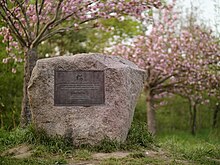Japaneck (also known as Japan-Eck) is the geographical name for the border triangle between Berlin and the Teltow-Fläming and Potsdam-Mittelmark districts of Brandenburg, Germany. It is the site of a memorial stone celebrating German reunification.

Location
editJapaneck is located between the district of Berlin-Lichterfelde (locality of Lichterfelde-Süd), Osdorf_(Großbeeren) in the Heinersdorf part of the Großbeeren community and the Sigridshorst district of the city of Teltow.[1]
At this point, the city border between Berlin and the surrounding area has a striking, almost right-angled bend. Until 1990, the border between West Berlin and the GDR ran here, with a wide strip for their border security installations that has remained largely undeveloped to this day.
The Diedersdorfer Heide and Großbeerener Graben nature reserve border it to the southeast. The former US military training area Parks Range bordered it on the Berlin side.
Story
editThe name Japaneck comes from the fact that reporters from the Japanese television company TV Asahi visited the city of Teltow in 1989. After the fall of the Berlin Wall, there was a fundraising campaign as part of the Sakura Campaign, supported by around 20,000 Japanese citizens.[2]
With the proceeds of around one million euros, over 1000 Japanese cherry trees (Prunus serrulata) were planted in April 1995.[3] Today, these trees form the 1.8 km long TV Asahi cherry blossom avenue[4] on the Brandenburg side along the Berlin state border from Japaneck in a northwesterly direction to Lichterfelder Allee, which is crossed roughly in the middle by the Berlin-Halle railway line (Anhalter Bahn) and the S-Bahn line to Teltow.
From late April to early May, the plants display their typical and striking pink petals during the Japanese cherry blossom season, which is celebrated every spring in the Japanese tradition of Hanami.
Memorial Stone
editJapaneck is marked by a memorial stone with an inscription and the translation of a haiku by Kobayashi Issa on a bronze plaque.
German text
editKirschbäume gespendet von japanischen Bürgern
aus Freude über die Vereinigung unseres Volkes,
unterstützt vom TV Asahi Network,
gepflanzt vom Sakura-Organisationskomitee.
April 1996
Unter den Zweigen
der Kirschbäume in Blüte
ist keiner ein Fremder hier.— Issa
English translation
editCherry trees donated by Japanese citizens
in joy for the unification of our people,
supported by TV Asahi Network,
planted by the Sakura Organizing Committee.
April 1996
Under the cherry blossoms
Strangers are not
Really strangers[5]— Issa
Original haiku in Japanese
edit花の陰
赤の他人は
なかりけり— 小林 一茶
References
edit- ^ "Japan-Eck Berlin, 12207 Berlin - Lichterfelde [Denkmal]". www.berliner-stadtplan.com. Retrieved 1 October 2024.
- ^ "How the Japanese cherry blossom ritual came to Germany – DW – 03/24/2023". dw.com. Retrieved 1 October 2024.
- ^ "Cherry Trees Along the Berlin Wall Trail". Orte der Einheit. Retrieved 1 October 2024.
- ^ "TV-Asahi-Kirschblütenallee". teltowerplatte.de. Retrieved 1 October 2024.
- ^ "Beauty in simplicity: creative expression in the Japanese haiku". varsity.co.uk. Varsity Online. Retrieved 1 October 2024.